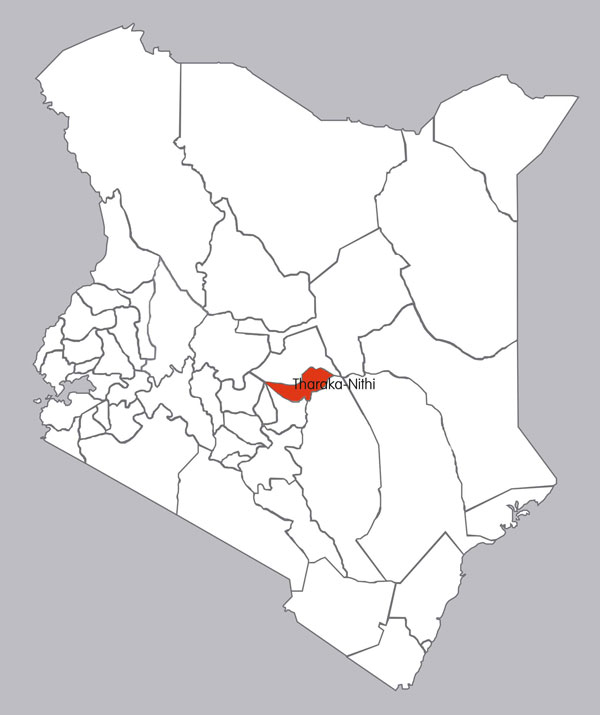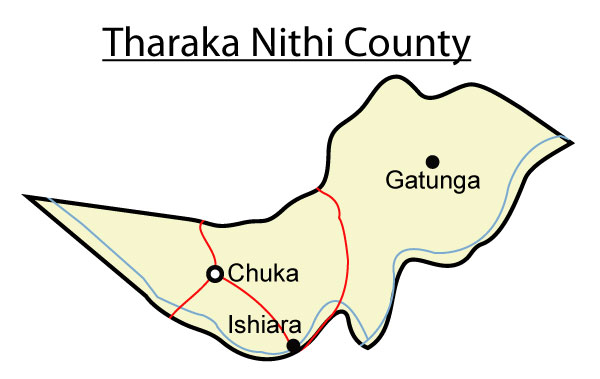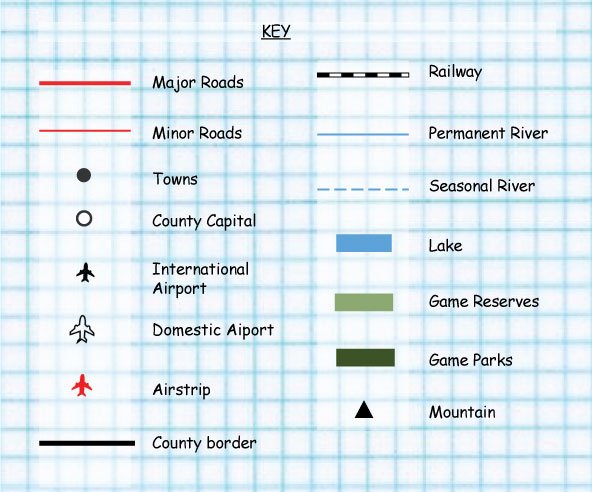Tharaka Nithi County
Introduction
This is one of the 47 counties of Kenya located in Kenya's former Eastern Province.
The county has an area of 2609 km² and had a population of 365,330 as of the 2009 census.
Tharaka-Nithi County is the home to the Chuka, Muthambi, Mwimbi and Tharaka sections of the Ameru (Meru) community.
The people of Tharaka-Nithi County are now predominantly Christian with the Catholics, the Presbyterian, and the Methodists being the predominant religious communities.

Constituencies
Tharaka Nithi County presently has 3 constituencies in the 11th Parliament of the Republic of Kenya.
- They are Maara Constituency - Represented by Hon. Japheth Kareke Mbiuki Chuka
- Igambang'ombe Constituency - Represented by Hon. Patrick Munene
- Tharaka Constituency - Represented by Hon. George Gitonga Murugara.
Main physical features
Rivers
- The region is traversed by several rivers, which originate from Mt. Kenya and Nyambene Hills, flowing eastwards as tributaries of Tana River. They include Mutonga, Thingithu, Kathita, Thanantu, Thangatha and Kithinu rivers. The region comprises of low, hilly, stony and sandy marginal lowlands with fair forest cover
Mountains
- Tharaka Nithi lies on the foothills of Mount Kenya
Hills
- Nyambene Hills - The Kiera hills and Muunguni form part of the Nyambene complex.
Valleys
Importance of physical features
- The rivers help in supplying water for farming hence a source of food and There is commercial trout fish farming sponsored by the Tharaka Fisheries initiative. The fish is reared in river Nithi Thuci and Mutonga.
- Mt Mount Kenya National Park offers untouched wilderness, exquisite scenery, mineral springs and endangered wildlife species for those who love camping, game viewing, bird watching, cave exploration and mountain climbing.
Importance of vegetation
- Vegetation releases oxygen and sequesters carbon.
- Vegetation affects soil development over time, generally contributing to a more productive soil.
- Vegetation provides wildlife habitat and food.
- Vegetation provides direct (e.g., timber) and indirect (e.g., watershed protection) socioeconomic products and services for humans.
- Vegetation gives spiritual and cultural experiences to some people.
- Vegetation can be easily described and mapped, and therefore can be used to: monitor changes in cover, composition, and structure due to natural or human-influenced events.
- Set conservation and habitat management goals.
Main types of natural vegetation
Map of distribution of the natural vegetation.


People and population
Language groups
Majority of the residents comprise the larger Ameru community namely Tharaka, Mwimbi, Muthambi and Chuka - all of whom speak the meru ethnic language, as well as Swahili and/or English. Other tribes found in small numbers include the Kikuyu, Kamba, Embu, Borana, and Somali among other ethnic groups of Kenya.
Areas of high population density
Areas of low population density
Social relations and cultural activities
Traditional way of life of the people
Food
Dressing
Songs and dances
- Kibuucho dance
- The Kirarire ritual song
Traditional medical practices
- Herbal drugs for malaria treatment
Ceremonies
- Birth and naming
- Initiation
Festivals
Resources and economic activities
Agriculture
Main cash crops and food crops grown
The areas where the cash crops are grown
- Magumoni
- Chuka
- Muthambi
- Mwimbi South
- Mwimbi North
- Mwimbi Central
Types of livestock kept
Fishing
Areas where fishing is practiced
- There is commercial trout fish farming sponsored by the Tharaka Fisheries initiative. The fish is reared in river Nithi Thuci and Mutonga.
Forestry
The major forests
- Most of the County forests are montane type found in the Mt. Kenya forest, Kiera hills and Muunguni hills. The Kiera hills and Muunguni form part of the Nyambene complex. Other gazzetted forests are Ntugi and Kijege. There are also a number of ungazetted forests such Mutaranga, Mutijwa, Maatha, Tunyai, Nkarini, Kiangsu, Gikingo, Muugi, Mariene, Kuiguni and Nyamantu Hills.
Wildlife and Tourism
The type’s of wildlife. They include;
- Elephants,
- Buffalo,
- Colobus and other monkeys,
- Cape buffalo,
- Antelope and giant forest hogs, inhabit the lower forests.
They are contained within the national park by electrified fences. The birdlife is also very prolific, including huge eagles and colorful sunbirds.
The game parks and reserves
- Mutejwa National Reserve. The reserve is hosts several wildlife species including rare gazelles, monkeys, ostriches and hundreds of birds in the forest that lines up along the Nithi River.
- Mount Kenya National Park offers untouched wilderness, exquisite scenery, mineral springs and endangered wildlife species for those who love camping, game viewing, bird watching, cave exploration and mountain climbing.
Major tourist attractions
- Mount Kenya
- Mount Kenya National park
- MutejwaNational Reserve
Industries
Traditional industries and the products
- Tea factories in Magumoni, Chuka, Muthambi, Mwimbi South, Mwimbi North and Mwimbi Central for processing tea.
Trade
The major trading centers


